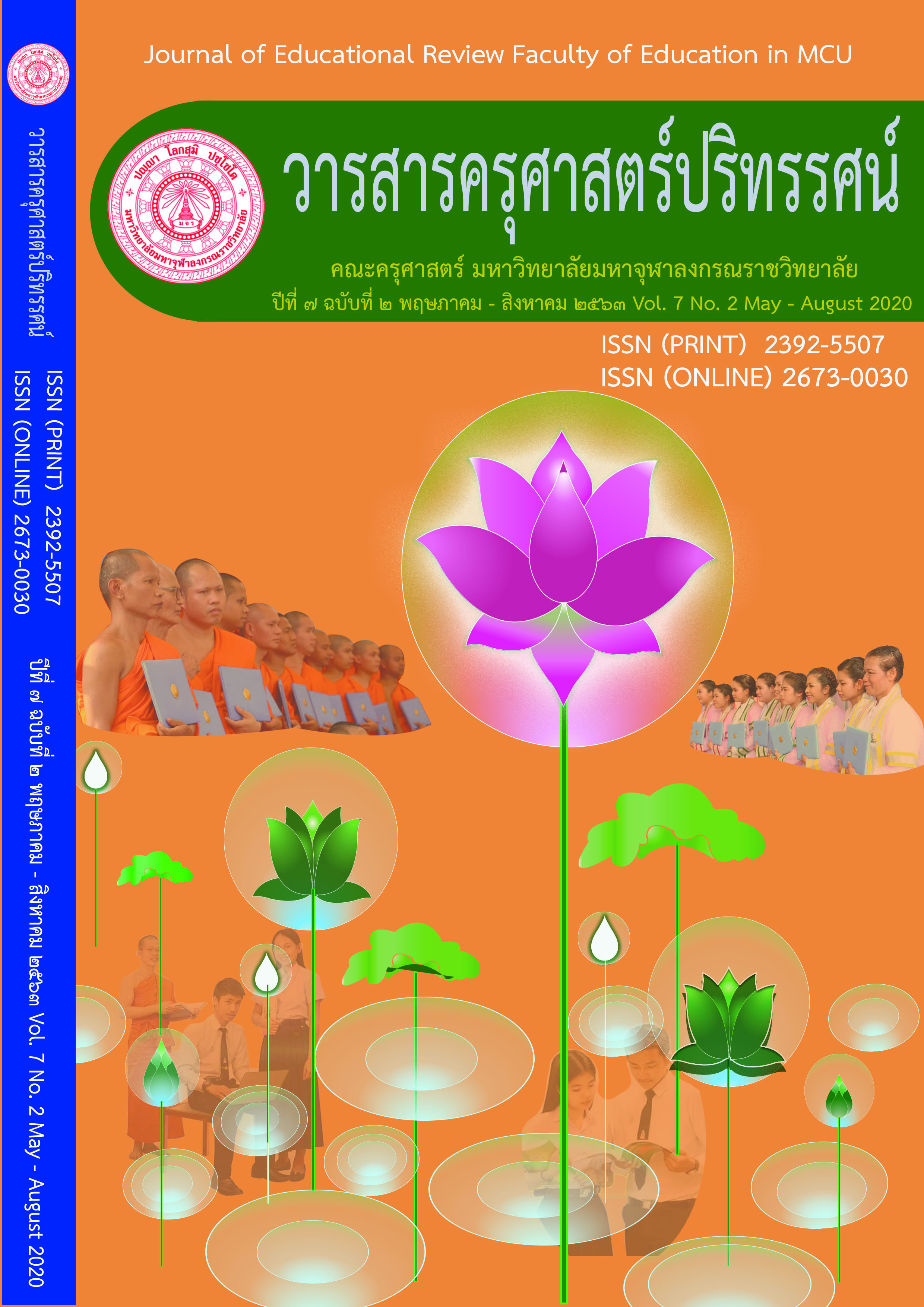GUIDELINES ON APPLICATION OF DESIGN THINKING FOR DESIGN THINKING MINDSET DEVELOPMENT OF TEACHERS: A CASE STUDY OF TEACHERS IN THE SECONDARY EDUCATIONAL SERVICE AREA OFFICE 2
Main Article Content
Abstract
The objectives of this research were to 1) to study into the context of the educational institutions as case study in applying the design thinking to develop teachers’ design thinking mindset, 2) to experiment and study into the results of the application of the design thinking to develop teachers’ design thinking mindset, 3) to synthesize the way in applying the design thinking to develop teachers’ design thinking mindset. There were 6 participants of the participatory action research who were the school administrators and teachers in such school by purposive sampling. The research methodology was divided into 3 stages by applying 5 steps related to the design thinking concept of Stanford d. School. Qualitative data analysis was performed by analyzing into the essential contents and by descriptive analysis. After that, the quantitative analysis into the data was performed by percentage, means, standard deviation, and developmental score scale. It was found from the research as follows: 1) The context of the educational institution had supporting factors including the fact that the administrators and the teachers realized the importance of the design thinking and already understand the basic of design thinking, also, there was an encouragement for the development of teachers by the preparation for Individual Development Plan, by creating Professional Learning Community, by Coaching and Mentoring; however, there were still limitations in terms of time and budget used in developing teachers. 2) According to the application of the design thinking in developing teachers’ design thinking mindset, it was found that the teachers liked 5 steps of the procedures and were willing to cooperate well; and the developmental score on the design thinking mindset was 30.10 by average. 3) There were 7 ways on to the application of the design thinking in developing teachers’ design thinking mindset as follows: 1) The specification of development policy into the annual action plan; 2) Holding the training to provide knowledge related to design thinking to people in the organization; 3) Opening channel to listen to various people’s opinions; 4) supporting the budget to be used in the development; 5) Supporting on the educational technology media that facilitate the development; 6) Supervising, directing, and following up the development of teachers constantly; 7) Boosting morale in order to motivate teachers in order for the development.
Article Details
ทัศนะและความคิดเห็นที่ปรากฏในบทความในวารสารฉบับนี้ถือเป็นความรับผิดชอบของผู้เขียนบทความนั้นเพียงผู้เดียว และไม่ถือเป็นทัศนะและความรับผิดชอบของกองบรรณาธิการ
กองบรรณาธิการขอสงวนสิทธิ์ในการคัดเลือกบทความลงตีพิมพ์และจะแจ้งให้เจ้าของบทความทราบหลังจากผู้ประเมินบทความตรวจอ่านบทความแล้ว
ต้นฉบับที่ได้รับการตีพิมพ์ในวารสารครุศาสตร์ปริทรรศน์ คณะครุศาสตร์ มหาวิทยาลัยมหาจุฬาลงกรณราชวิทยาลัย ถือเป็นกรรมสิทธิ์ของคณะครุศาสตร์ มหาวิทยาลัยมหาจุฬาลงกรณราชวิทยาลัย ห้ามนำข้อความทั้งหมดหรือบางส่วนไปพิมพ์ซ้ำ เว้นเสียแต่ว่าจะได้รับอนุญาตจากมหาวิทยาลัยฯ เป็นลายลักษณ์อักษร
References
จิราภรณ์ ตั้งกิตติภาภรณ์. (2556). จิตวิทยาทั่วไป. กรุงเทพมหานคร: สำนักพิมพ์แห่งจุฬาลงกรณ์มหาวิทยาลัย.
จิราภา เพียรเจริญ. (2556). บทบาทของผู้บริหารในการส่งเสริมการจัดการเรียนรู้ของครูตามหลักสูตรสถานศึกษาขั้นพื้นฐานในโรงเรียนมัธยมศึกษา จังหวัดปทุมธานี. วิทยานิพนธ์ศึกษาศาสตรมหาบัณฑิต. มหาวิทยาลัยธุรกิจบัณฑิตย์.
นุชจรี กิจวรรณ. (2561). กระบวนการคิดเชิงออกแบบ: มุมมองใหม่ของระบบสุขภาพไทย. วารสารสภาการพยาบาล. 33(1). 5-14.
วีระยุทธ ชาตะกาญจน์. (2557). การวิจัยเพื่อพัฒนาการบริหารการศึกษา. กรุงเทพมหานคร: สำนักพิมพ์แห่งจุฬาลงกรณ์มหาวิทยาลัย.
ศศิมา ตุ้มนิลกาล. (2560). การนำเสนออัตลักษณ์บนเครือข่ายสังคมออนไลน์อินสตาแกรมของเจเนอเรชั่น: กรณีศึกษาความแตกต่างระหว่างเจเนอเรชั่นเอ็กซ์ เจเนอเรชั่นวาย และเจเนอเรชั่นแซด. วิทยานิพนธ์นิเทศศาสตรมหาบัณฑิต. มหาวิทยาลัยกรุงเทพ.
ศุภามาศ แก้วดวงดี. (2553). แนวทางการพัฒนาบุคลากร: กรณีศึกษาองค์การบริหารส่วนจังหวัดสตูล.วิทยานิพนธ์รัฐประศาสนศาสตรมหาบัณฑิต. มหาวิทยาลัยรามคำแหง (จังหวัดสงขลา).
สำนักงานคณะกรรมการการศึกษาขั้นพื้นฐาน. (2561). สถิติทางการศึกษา ปี 2560. กรุงเทพมหานคร: สำนักงานคณะกรรมการการศึกษาขั้นพื้นฐาน.
สำนักงานคณะกรรมการการอาชีวศึกษา. (2560). คู่มือการประเมินตนเองและการจัดทำแผนพัฒนาตนเองรายบุคคล (ID PLAN) ของครูสายงานการสอน สังกัดสำนักงานคณะกรรมการการอาชีวศึกษา. กรุงเทพมหานคร: สำนักงานคณะกรรมการการอาชีวศึกษา.
สำนักงานเลขาธิการสภาการศึกษา. (2558). สภาพการผลิตและพัฒนาครูในประเทศไทย. กรุงเทพมหานคร: พริกหวานกราฟฟิค.
สุนทร วงศ์ไวศยวรรณ. (2540). วัฒนธรรมองค์การ แนวคิด งานวิจัยและประสบการณ์. กรุงเทพมหานคร: โฟร์เพซ.
อรรณพ จีนะวัฒน์. (2559). การพัฒนาตนของผู้ประกอบวิชาชีพครู. วารสารมหาวิทยาลัยศิลปากร. 9(2). 1379-1395.
Dweck, C. S. (2006). Mindset: The new psychology of success. New York: Random House.
IDEO. (2009). Human-Centered Design Toolkit. IDEO.
Likert, R. (1987). The human organization: Its management and value. New York: McGraw - Hill.
Schweitzer et al. (2015). The Design Thinking Mindset: An Assessment of What We Know and What We See in Practice. Researchgate.
Stanford d.school. (2009). Design Thinking Bootcamp Bootleg. from https://static1.squarespace.com/static/57c6b79629687fde090a0fdd/t/58890239db29d6cc6c3338f7/1485374014340/METHODCARDS-v3-slim.pdf. Retrieved September 29, 2019


